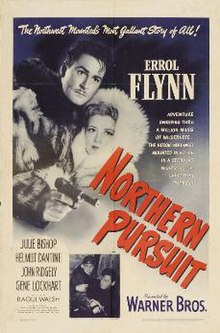
Errol Leslie Thomson Flynn was an Australian-American actor who achieved worldwide fame during the Golden Age of Hollywood. He was known for his romantic swashbuckler roles, frequent partnerships with Olivia de Havilland, and reputation for his womanising and hedonistic personal life. His most notable roles include Robin Hood in The Adventures of Robin Hood (1938), which was later named by the American Film Institute as the 18th-greatest hero in American film history, the lead role in Captain Blood (1935), Major Geoffrey Vickers in The Charge of the Light Brigade (1936), and the hero in a number of Westerns such as Dodge City (1939), Santa Fe Trail, Virginia City and San Antonio (1945).
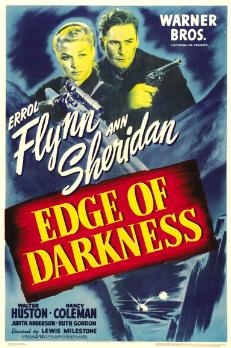
Edge of Darkness is a 1943 World War II film directed by Lewis Milestone that features Errol Flynn, Ann Sheridan, and Walter Huston. The feature is based on a script written by Robert Rossen which was adapted from the 1942 novel The Edge of Darkness by William Woods.

Helmut Dantine was an Austrian-American actor who often played Nazis in thriller films of the 1940s. His best-known performances are perhaps the German pilot in Mrs. Miniver and the desperate Bulgarian refugee in Casablanca, who tries gambling to obtain travel visa money for himself and his wife. As his acting career waned, he turned to producing.
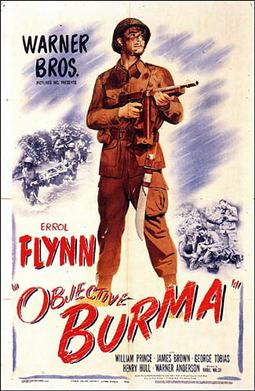
Objective, Burma! is a 1945 American war film that is loosely based on the six-month raid by Merrill's Marauders in the Burma Campaign during the Second World War. Directed by Raoul Walsh and starring Errol Flynn, the film was made by Warner Bros. immediately after the raid. The plot of the film is almost a carbon copy of "Northwest Passage"; an MGM production which starred Spencer Tracy released in 1940.

They Died with Their Boots On is a 1941 American biographical western war film directed by Raoul Walsh and starring Errol Flynn, Olivia de Havilland and Arthur Kennedy. It was made and distributed by Warner Bros. and produced by Hal B. Wallis and Robert Fellows,

Air Force is a 1943 American World War II aviation film directed by Howard Hawks and starring John Garfield, John Ridgely, Gig Young, Arthur Kennedy, and Harry Carey. The film was distributed by Warner Bros. and produced by Hal B. Wallis and Jack L. Warner. It contains incidents of supposed fifth-column activities by Japanese Americans that never happened. Conceived by then - Lieutenant General “Hap” Arnold in the aftermath of the Pearl Harbor attack, it was originally scheduled for release on December 7, 1942, on the first anniversary. It became impossible to meet that deadline, and it premiered in New York City on February 3, 1943 and was released on March 20. The film's storyline revolves around an actual event that occurred on December 7, 1941. An aircrew ferries an unarmed 1940 series Boeing B-17D Flying Fortress heavy bomber, named the Mary-Ann, across the Pacific to the United States Army Air Forces base at Hickam Field. They fly right into the middle of the Japanese air attack on Pearl Harbor and the beginning of America's major involvement in the Second World War. An uncredited William Faulkner wrote the emotional deathbed scene for Ridgely, who played the commander and pilot of the Mary-Ann.

Background to Danger is a 1943 World War II spy thriller film starring George Raft and featuring Brenda Marshall, Sydney Greenstreet, and Peter Lorre.
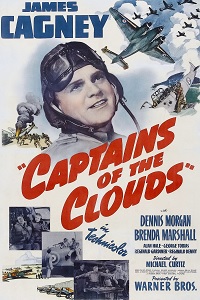
Captains of the Clouds is a 1942 American war film in Technicolor, directed by Michael Curtiz and starring James Cagney. It was produced by William Cagney, with Hal B. Wallis as executive producer. The screenplay was written by Arthur T. Horman, Richard Macaulay, and Norman Reilly Raine, based on a story by Horman and Roland Gillett. The cinematography was by Wilfred M. Cline and Sol Polito and was notable in that it was the first feature-length Hollywood production filmed entirely in Canada.

Fighter Squadron is a 1948 American World War II aviation war film in Technicolor from Warner Bros., produced by Seton I. Miller, directed by Raoul Walsh, that stars Edmond O'Brien, Robert Stack, and John Rodney.

Desperate Journey is a 1942 American World War II action and aviation film directed by Raoul Walsh and starring Errol Flynn and Ronald Reagan. The supporting cast includes Raymond Massey, Alan Hale Sr., and Arthur Kennedy. The melodramatic film featured a group of downed Allied airmen making their way out of the Third Reich, often with their fists.

Gentleman Jim is a 1942 film directed by Raoul Walsh and starring Errol Flynn as heavyweight boxing champion James J. Corbett (1866–1933). The supporting cast includes Alexis Smith, Jack Carson, Alan Hale, William Frawley, and Ward Bond as John L. Sullivan. The movie was based upon Corbett's 1894 autobiography, The Roar of the Crowd. The role was one of Flynn's favorites.
Hans Heinrich von Twardowski was a German film actor.

Louis V. Arco was an Austrian stage and film actor whose career began in the late 1910s.

San Antonio is a 1945 American Western film starring Errol Flynn and Alexis Smith. The film was written by W. R. Burnett and Alan Le May and directed in Technicolor by David Butler as well as uncredited Robert Florey and Raoul Walsh.

The film appearances of movie actor Errol Flynn (1909–1959) are listed here, including his short films and one unfinished feature.

Dive Bomber is a 1941 American aviation drama film directed by Michael Curtiz, and starring Errol Flynn, Fred MacMurray and Alexis Smith. It was produced and distributed by Warner Brothers. The film is notable for both its Technicolor photography of pre-World War II United States Navy aircraft and as a historical document of the U.S. in 1941. This includes the aircraft carrier USS Enterprise, one of the best-known U.S. warships of World War II.
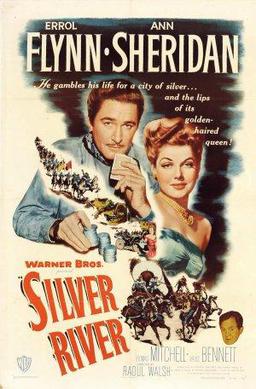
Silver River is a 1948 American western film directed by Raoul Walsh and starring Errol Flynn, Ann Sheridan and Thomas Mitchell. The film is based on a Stephen Longstreet story that was turned into a novel. It was produced and distributed by Warner Bros.
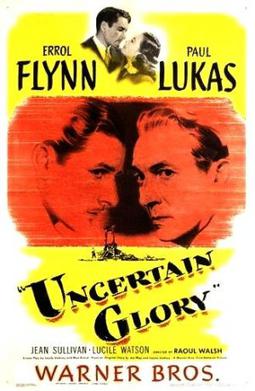
Uncertain Glory is a 1944 American World War II crime drama film, directed by Raoul Walsh and starring Errol Flynn and Paul Lukas.
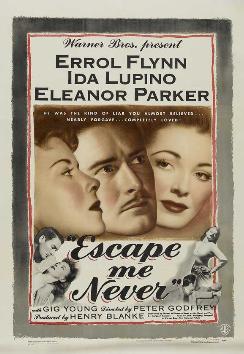
Escape Me Never is a 1947 American melodrama film directed by Peter Godfrey, and starring Errol Flynn, Ida Lupino, Eleanor Parker, and Gig Young.
My Wicked, Wicked Ways is a 1985 American TV movie based on My Wicked, Wicked Ways, the best selling memoir of Errol Flynn, with Duncan Regehr as Flynn and Barbara Hershey as Lili Damita.
